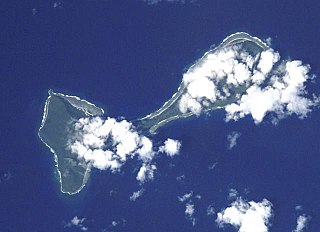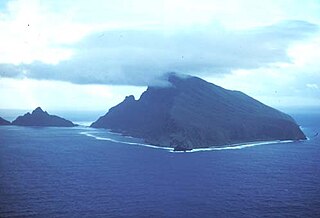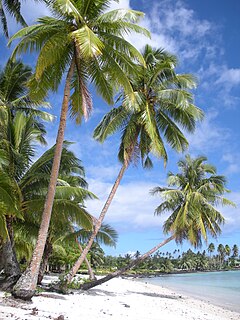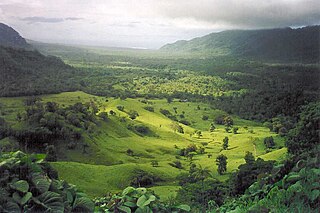Nu'ulua, not to be confused with Nu'ulua 200 meters west of Ofu, is an island in Samoa in the Aleipata Islands situated more than 1.3 km from the eastern end of Upolu in Samoa.

Ofu and Olosega are parts of a volcanic doublet in the Manu‘a Group of the Samoan Islands—part of American Samoa. The twin islands, formed from shield volcanoes, have a combined length of 6 km and an area of 12 square kilometers ; their population is about 500 people. They are geographic volcanic remnants separated by the narrow 137-meter-wide (449-foot) Asaga strait, a natural bridge of shallow coral reef. Before 1970, one had to wade between the two islands at low tide; now a single-lane road bridge over the strait connects villages on Ofu island with those on Olosega.

The Aleipata Islands is a group of four uninhabited islands off the eastern end of Upolu Island, Samoa, with an aggregate area of 1.68 km²):

Upolu is an island in Samoa, formed by a massive basaltic shield volcano which rises from the seafloor of the western Pacific Ocean. The island is 75 kilometres long and 1,125 square kilometres in area, making it the second largest of the Samoan Islands geographically. With approximately 145,000 people, it is by far the most populated of the Samoan Islands. Upolu is situated to the southeast of Savai'i, the "big island". Apia, the capital, is in the middle of the north coast, with Faleolo International Airport at the western end of the island. The island has not had any historically recorded eruptions, although three lava flows date back only a few hundred to a few thousand years.
Nu'ulua has a land area of 25 hectares and is a habitat for locally and regionally endemic birds including the endangered tooth-billed pigeon, (Didunculus strigirostris), also known as Samoan pigeon, and an endemic bat (Pteropus samoensis). [1]

The tooth-billed pigeon, also known as the manumea, is a large pigeon found only in Samoa. It is the only living species of genus Didunculus. A related extinct species, the Tongan tooth-billed pigeon, is only known from subfossil remains in several archeological sites in Tonga. The tooth-billed pigeon is the national bird of Samoa and featured on the 20 tālā bills and the 50 sene pieces of the 2008/2011 series.
Together with Nu'utele, another small island in the Aleipata Islands, the two isles hold the largest seabird colonies in Samoa and identified as highly significant sites for conservation. The conservation project has included efforts to eradicate the presence of Pacific rats (Rattus exulans) which prey on native insects, birds and lizards on the islands. [2]

Nu'utele is an island which consists of a volcanic tuff ring situated 1.3 km off the eastern end of Upolu island, Samoa. It is the largest of the four Aleipata Islands, at 1.08 km2.
These islets are remnants of eroded volcanic tuff ring. [3]

A volcano is a rupture in the crust of a planetary-mass object, such as Earth, that allows hot lava, volcanic ash, and gases to escape from a magma chamber below the surface.
Ownership of both islands rests with customary chiefly titles in the villages of Aleipata on Upolu.










